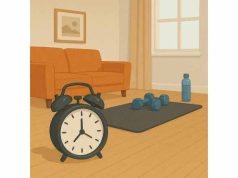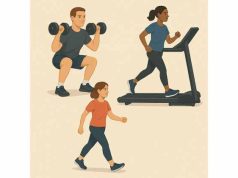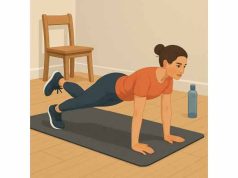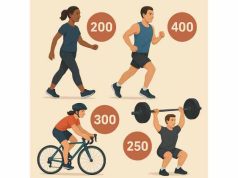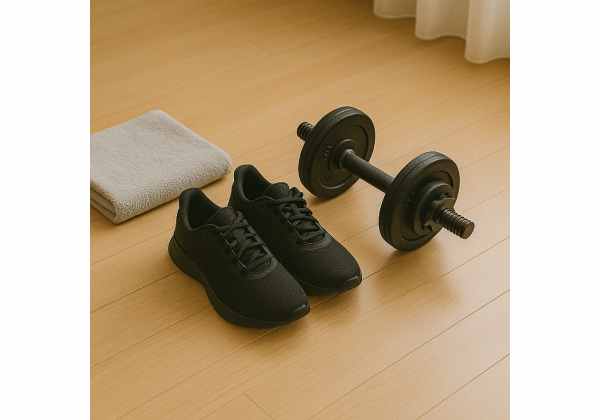
Fasted cardio is simple: you perform low-to-moderate exercise before your first meal, usually after an overnight fast. Some people love the focus and convenience. Others feel flat and underpowered. This guide explains what fasted cardio does, what it does not do, and how to decide whether it fits your goals. You will learn practical protocols, safety steps, fueling options, and troubleshooting so your plan remains both effective and sustainable. For the broader framework that blends strength, cardio, and daily steps into one fat-loss plan, see our overview of evidence-based exercise for losing body fat, then return here to tailor fasted sessions—if they suit you.
Table of Contents
- Does fasted cardio work?
- Pros and cons
- Who it suits—and who should avoid it
- How to do it safely
- Sample fasted-cardio workouts
- Nutrition and recovery around fasted training
- Tracking progress and troubleshooting
- Frequently Asked Questions
Does fasted cardio work?
Fasted cardio increases fat use during the workout for many people. After an overnight fast, insulin is lower and circulating carbohydrate is limited, so your body leans more on fat for fuel at submaximal intensities. That is an acute effect. The outcome that most people care about—body-fat loss over weeks—depends on your total calorie balance, weekly activity, and muscle retention, not on which fuel you burned during a single session.
Here is a practical way to think about it:
- Session fuel mix (fat vs. carbohydrate) is not the same as body-fat change. You can oxidize more fat during a workout and still not lose fat if total intake exceeds what you expend that day or week.
- Fasted cardio can make adherence easier: mornings are quiet, and there is less pre-workout logistics. Consistency drives results.
- Training quality matters. If fasted sessions consistently reduce your output, your weekly energy burn and fitness gains may be lower than with a light pre-session snack.
How does it compare with fed cardio for fat loss?
- Over matched programs, long-term fat loss is similar when calories and training volumes are alike. The best choice is the one you repeat without excessive fatigue, hunger rebounds, or performance drops.
- Fasted sessions pair well with low-to-moderate intensity work such as brisk walking, incline treadmill, easy cycling, or elliptical. High-intensity intervals demand glycogen; doing too many hard intervals fasted often feels poor and may reduce quality.
Where fasted cardio fits in a smart plan:
- Use it for short, repeatable sessions (20–45 minutes) on mornings when you prefer to train before breakfast.
- Keep two short strength sessions each week to preserve muscle, because strength work determines what you keep while the scale moves.
- Align with sustainable nutrition. For clear, realistic anchors, see our concise guide to weight-loss basics.
Pros and cons
Fasted cardio is a tool. Like any tool, it is helpful when used for the right job and the right person.
Potential advantages
- Convenience and routine. Morning sessions happen before daily demands pile up. Fewer decisions means more consistency.
- Perceived focus. Many feel mentally clear without a recent meal, which can help with early starts.
- Reduced GI discomfort. Training empty avoids sloshing and side stitches that some experience after eating.
- Slightly higher fat oxidation in-session. At comfortable efforts, your body may use a higher proportion of fat for fuel compared with a fed session at the same intensity.
Limitations and risks
- Performance trade-off at higher intensities. Sprint or threshold work often suffers without carbohydrate on board, which can blunt fitness progress if you push hard regularly.
- Hunger rebound. Some overeat later due to heightened appetite, erasing the session’s energy gap.
- Stress interactions. Very early, under-fueled training plus short sleep can feel like “stacked stress,” raising fatigue across the day.
- Individual variability. Some feel flat, dizzy, or nauseated when exercising without food. That is a red flag to modify or avoid the approach.
When fasted is more likely to help
- You enjoy early training and want a simple routine.
- Your sessions are easy to moderate (Zone 1–2) or short intervals with ample recovery.
- You have a reliable breakfast habit afterward to re-fuel and keep appetite steady.
When fed is often better
- You plan HIIT or tempo runs that rely on glycogen.
- You struggle with lightheadedness or poor sleep.
- You notice afternoon overeating after morning fasted sessions.
If you want a deeper comparison of training styles, our overview of intervals versus steady cardio explains how each drives progress and how to combine them during a fat-loss phase.
Who it suits—and who should avoid it
Fasted cardio suits some profiles well and is inappropriate or risky for others. Align the method with your context, health status, and goals.
Good candidates
- Time-pressed adults who can consistently fit 20–45 minutes before breakfast and appreciate the routine.
- People focused on easy aerobic conditioning—walking, incline treadmill, cycling, elliptical—at conversational efforts.
- Individuals who feel comfortable training on an empty stomach and do not experience dizziness, nausea, or headaches.
Proceed with caution or avoid without medical clearance
- Diabetes or blood-sugar disorders. Medication and insulin timing complicate morning exercise without food. Get individualized guidance.
- Pregnancy or postpartum. Prioritize comfort, blood-sugar stability, and clinician advice.
- History of disordered eating. Fasting protocols can be triggering; choose fed training and structured meals instead.
- Low blood pressure, anemia, or dizziness with prior fasted exercise.
- Athletes chasing peak power or speed. Quality matters more than timing; a small pre-session snack often improves outcomes.
Scheduling choices that help
- Use fasted mornings for low-impact base work and save hard intervals for days when you can have a small pre-session carb + protein snack.
- If you prefer mornings and hard efforts, consider a light pre-workout (e.g., banana, yogurt) and treat it as “semi-fasted.” Performance usually improves with no downside to fat loss.
Because daily movement outside workouts also influences results, many people flourish by pairing fasted sessions with more steps across the day. For practical ways to raise that baseline without “doing more cardio,” skim our quick guide to increasing everyday activity.
How to do it safely
Fasted training should feel steady, controlled, and repeatable. Use this checklist to protect performance and well-being.
1) Choose suitable intensities
- Emphasize Zone 2 or conversational pace. You should breathe steadily and speak in full sentences.
- Limit hard intervals fasted. If you include them, keep them short with ample recovery (e.g., 30–60 seconds hard, 60–90 seconds easy) and stop if form degrades. For a plain-English primer on aerobic zones, see our guide to easy endurance work.
2) Keep sessions time-bound
- Start with 20–30 minutes and extend to 45 minutes if you feel strong. Very long fasted efforts are not necessary for fat loss and may increase fatigue.
3) Hydrate and add electrolytes when needed
- Drink water on waking. In hot conditions or if you sweat heavily, add a low-calorie electrolyte. Dehydration, not lack of food, is the common cause of early-session fatigue.
4) Warm up gradually
- Use 5–8 minutes to ramp from easy to moderate with a couple of short pickups. Sudden intensity spikes feel harsher when fasted.
5) Monitor signals
- Stop the session if you feel lightheaded, nauseated, or unusually weak. Adjust intensity, shorten duration, or try a small pre-session snack next time.
6) Plan the meal that follows
- Eat within 1–2 hours after finishing: protein, fiber-rich carbohydrates, and fluids. This stabilizes appetite and supports recovery.
7) Strength placement
- If you lift on the same day, schedule strength later with food on board. Fasted lifting is not required and often compromises quality. For a simple, joint-friendly strength template, our 3-day plan pairs well with morning cardio.
Sample fasted-cardio workouts
Select one modality you enjoy and can repeat: brisk walk, incline treadmill, bike, elliptical, rower, or outdoor easy run if impact is well-tolerated. These templates include warm-ups and cool-downs.
10–20 minutes: entry level
- Option A (walk or elliptical): 5′ easy → 8× (30″ brisk / 60″ easy) → 3′ easy
- Option B (bike): 4′ easy → 10× (20″ strong / 40″ easy) → 4′ easy
- Goal: finish feeling you could do one more round. Increase rounds before raising intensity. For more short formats, browse our 20-minute sessions.
25–30 minutes: base builder
- Option A (incline treadmill): 5′ easy → 20′ steady at brisk pace, 2–5% grade → 5′ easy
- Option B (bike or elliptical): 6′ easy → 4× (3′ strong / 2′ easy) → 4′ easy
30–40 minutes: mixed aerobic with surges
- Option A (walk/jog): 6′ easy walk → 3× [6′ brisk walk or easy jog + 30″ surge / 30″ easy] → 4′ easy
- Option B (rower): 5′ easy → 3× [5′ steady + 4× (20″ strong / 40″ easy)] → 4′ easy
Low-impact interval set (any machine)
- 6′ easy → 30″ hard / 30″ easy × 10–14 → 4′ easy
- Keep posture tall, breathing steady, and cadence smooth. If form slips, reduce resistance or shorten the hard segments.
Weekly rhythms that work
- 3-day schedule: Mon base (25–30′), Wed intervals (20–25′), Sat base (30–40′).
- 4-day schedule: Add an easy recovery day (20–25′) or a technique spin.
On busy weeks, swap a base session for a 30-minute fat-burning template from our busy-day library.
Nutrition and recovery around fasted training
The method is “fasted,” not “under-recovered.” You still need protein, fiber, fluids, and sleep to support fat loss and performance.
Before the session
- Water on waking. If you prefer, black coffee or unsweetened tea is reasonable.
- If you consistently feel flat, consider a small pre-session snack (banana, yogurt, toast with honey) and evaluate performance. Slightly better output often outweighs any theoretical benefit of strict fasting.
After the session
- Within 1–2 hours, eat a balanced meal:
- Protein: ~20–40 g for most adults (eggs, dairy, lean meats, tofu).
- Fiber-rich carbs: fruit, oats, whole-grain toast, or potatoes.
- Fluids + electrolytes as needed.
- Avoid very large “reward” meals that overshoot your daily target. Plan portions in advance.
Throughout the day
- Aim for 1.6–2.2 g/kg/day of protein distributed across 3–4 meals.
- Keep calorie-dense extras (oils, sweets, alcohol) measured rather than unrestricted.
- High-volume, high-fiber foods help satiety; add vegetables and fruit to most plates.
Sleep and stress
- Target 7–9 hours. Poor sleep increases hunger and reduces training quality.
- Keep at least one true rest day weekly. Insert a deload (about −30% volume) every 4–6 weeks if fatigue accumulates.
If you prefer later training, that is fine. Morning versus evening does not determine fat loss; consistent training and energy control do. For scheduling trade-offs, see our brief note on morning vs. evening sessions.
Tracking progress and troubleshooting
Use simple, repeatable markers. Avoid judging progress by a single weigh-in or a watch’s calorie estimate.
What to measure
- Performance: time or distance at a set RPE; average cadence or pace for your preferred 20-minute steady test; number of clean intervals completed.
- Body composition proxies: weekly average weight (use three morning weigh-ins), waist and hip every two weeks, monthly photos in similar lighting.
- Behavior: sessions completed, total minutes moved, daily steps.
If fat loss stalls, change one variable for 10–14 days
- Add 5 minutes to a base session or one interval to an interval day.
- Nudge resistance or incline while keeping cadence smooth.
- Reduce daily intake by ~200 kcal from calorie-dense extras; keep protein steady.
- Increase step count by 1,500–2,500/day.
- Insert a deload week if fatigue, poor sleep, or irritability rise.
Common problems and fixes
- Lightheadedness during fasted training: shorten sessions, lower intensity, and try a small pre-session snack next time.
- Ravenous afternoon hunger: eat a protein-rich breakfast after training, prioritize fiber, and keep consistent meal timing.
- Flat performance: shift hard sessions to fed training days; keep fasted days easy-to-moderate.
- Knee or foot discomfort: pick low-impact modalities (incline walk, cycling, elliptical) and ensure supportive footwear. For joint-friendly options, skim our low-impact cardio guide.
Remember: fasted cardio is optional. If it helps you train consistently and feel well, keep it. If it creates friction, switch to a fed approach without worry—you are not missing a fat-loss “hack.”
Frequently Asked Questions
Does fasted cardio burn more fat overall?
It increases fat use during the session for many people, but long-term fat loss depends on weekly calorie balance, training volume, and muscle retention. When programs are matched for calories and effort, total fat loss is similar between fasted and fed cardio.
How long should fasted cardio last?
Start with 20–30 minutes and extend to 45 minutes if you feel strong and recover well. Very long fasted sessions are unnecessary for fat loss and often raise fatigue or hunger later in the day.
Is fasted cardio good for HIIT?
Usually not. High-intensity work relies on glycogen. Without carbohydrate on board, quality drops and perceived effort spikes. If you love morning HIIT, a small carb-protein snack improves output with no downside to fat loss.
What should I drink before fasted cardio?
Water on waking is enough for most short sessions. In heat or if you sweat heavily, add a low-calorie electrolyte. Coffee or unsweetened tea is fine if it does not upset your stomach.
Should I lift weights fasted?
It is not required and often compromises quality. Most people perform better and preserve muscle more effectively when strength sessions are fed. Use mornings for easy cardio and place lifting later with a normal pre-workout meal.
Who should avoid fasted cardio?
People with diabetes or blood-sugar disorders, those who are pregnant or postpartum, anyone with a history of disordered eating, or individuals who experience dizziness while training without food should avoid it or obtain medical clearance first.
Will fasted cardio target belly fat?
No method of exercise can spot-reduce abdominal fat. Waist definition improves as overall body fat decreases. Focus on sustainable nutrition, consistent training, strength work to preserve muscle, and adequate sleep.
References
- The acute effect of fasted exercise on energy intake, energy expenditure, subjective hunger and gastrointestinal hormone release compared to fed exercise in healthy individuals: a systematic review and network meta-analysis 2022 (Systematic Review)
- The effects of acute bouts of exercise in fasted vs. fed states on glucose and lipid metabolism in healthy adults: A systematic review and meta-analysis of randomized clinical trials 2025 (Systematic Review)
- Body composition changes associated with fasted versus non-fasted aerobic exercise 2014 (RCT)
- Systematic review and meta-analysis of protein intake to support muscle mass and function in healthy adults 2022 (Systematic Review)
- Standards of Care in Diabetes—2025 Abridged for Primary Care 2025 (Guideline)
Medical Disclaimer
This content is educational and not a substitute for personalized medical advice. Consult a qualified professional before changing your exercise or nutrition plan—especially if you have cardiovascular, metabolic, or orthopedic conditions; take medications that affect blood sugar or heart rate; are pregnant or postpartum; or are returning after injury or surgery.
Share and Stay Connected
If this guide helped you decide whether fasted cardio fits your plan, consider sharing it and follow us on your preferred platform. Your support allows us to keep producing clear, evidence-informed resources.



